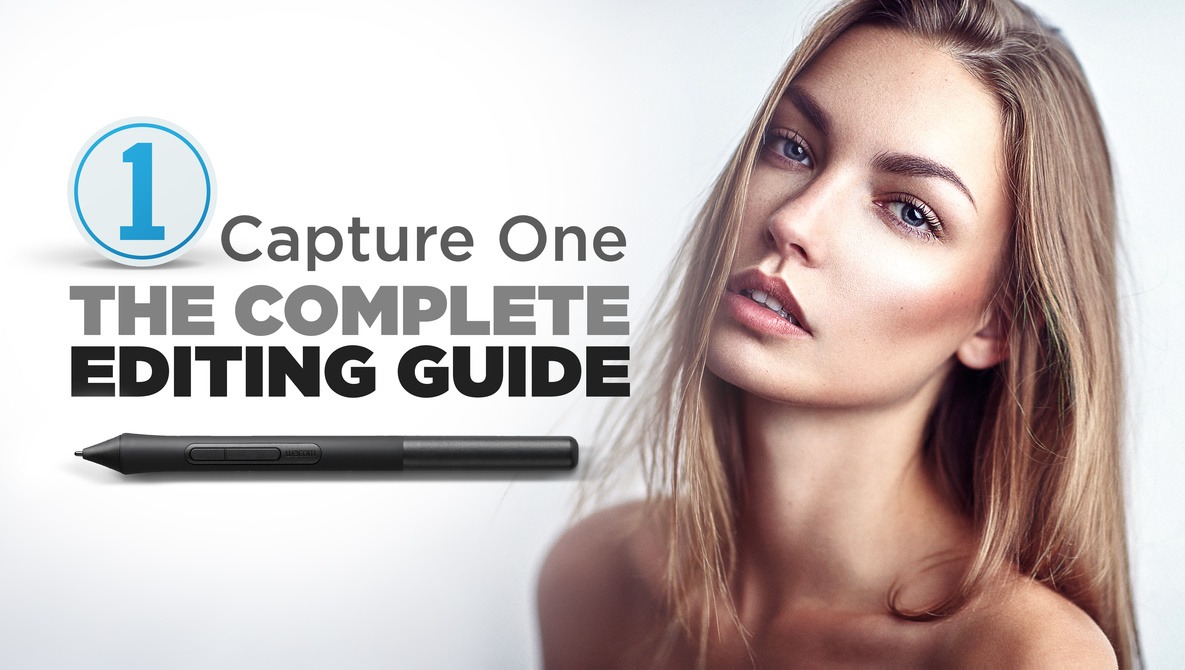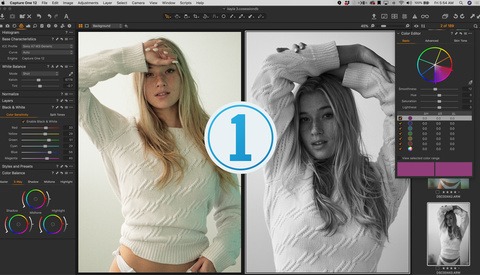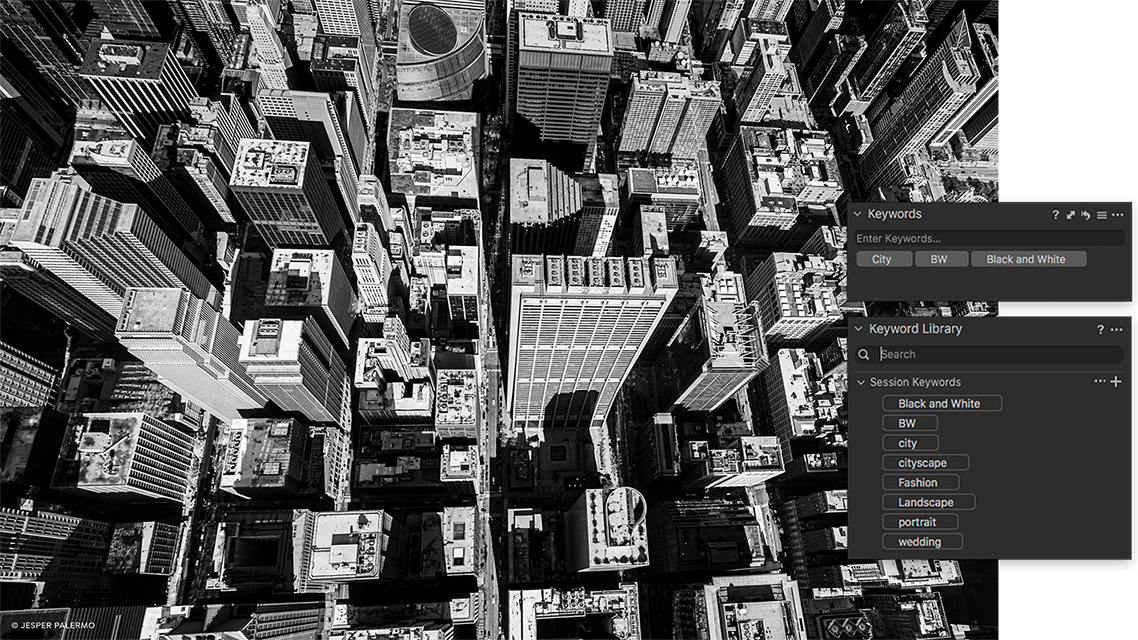In the first part, we’ve customized our workspace and shortcuts for batch editing. Also, we made sure that all the basic adjustments are applied before the processing. Now, it’s time to start editing images.
Capture One is an image editing software made by the company Phase One. The software is used by amateur and professional photographers to catalogue, edit, and process image files. The software is also capable of tethering (connecting a camera to an external monitor) so that photographers can color-check their images in real-time. Get the best possible starting point for your editing. Capture One renders RAW files with true-to-life colors that are custom profiled to all major camera brands. Capture One Pro is the industry leading image editing software, and the complete solution for offering high performance, tethered capture, comprehensive file handling and output to final formats Capture One Pro offers tools and solutions for every type of photographer, making asset management simple, fast and effective.
To make batch editing quick and effective, you need to follow these three principles:
- Work with groups of images
- Speed up all individual adjustments
- Practice quality control
Let’s start with group editing since that’s an essential part of the batch workflow.
Batch editing is all about copying and pasting adjustments.
You need to do as little of corrections as possible and copy/paste all the other.
Of course, you have to crop each image separately, as well as to fix some individual exposure/color issues. Still, most of the events have groups of photos taken in similar conditions. Thus, you can edit only one image from a group and copy/paste adjustments to other images from this group. After that, simply check each image in the group quickly and apply individual adjustments if needed. Then proceed to the next group.
How many images should be in a group?
It solely depends on shooting conditions. Groups of images for outdoor events can easily include 10-20 shots. Indoor events tend to be more varied in lighting. Thus your groups of images will be rather small: 5-10 photos taken in similar situations. If you’ve been lucky enough to shoot an event on a mildly cloudy day in a single outdoor location, your groups of images can consist of 30 pictures or even more.
What if my event contains images from mixed conditions?
That happens. Sometimes you can take images of several different conditions in a single room. In this case, I recommend you to color tag some “sample” shots of each condition to be able to return to them to copy adjustments quickly.
How to edit the first “sample” image in the group?
As you remember, we have set all the basic adjustments before processing. So we don’t need to worry about general corrections; they should be fine. Instead, focus on what has to be fixed on a particular image and copy/apply these adjustments to similar RAWs.
For instance, you see a series of images with incorrect white balance, noticeable color cast, and dark shadows. Fix WB, remove a color cast with Color Editor, brighten black areas with HDR, and copy/paste these adjustments to all images in this group.
Capture One Editing
Sounds great, but what to do when a crop from sample images is applied to all images in the series?
Fortunately, you can easily turn off auto-copying of the crop in the Adjustments Clipboard settings. Click “…”, go to Autoselect and choose Adjusted except Composition:

What about layers? What if I had made layer correction on a sample image?
Well, there are two ways to avoid copying layers:
1) Adjust all except for layers, copy these corrections, and add some layer corrections. Basically, you need to think in copyable/non-copyable categories of editing. All that can be copied should be adjusted before copying. All non-copyable adjustments should be applied after that.
2) Turn off autoselect of adjustments in the clipboard and select everything manually, except for layers and composition. Thus, Capture One will always copy/apply everything, excluding layers and composition adjustments.
I prefer the first method because sometimes you actually need to copy layers too.
So, we’ve figured out that batch editing is all about copying adjustments in groups of similar images. Still, you can’t get rid of individual adjustments.
How to speed up all the individual corrections you need to apply?
Let’s see which adjustments you’ll typically apply and how to do it faster.
Crop
It’s the most used individual correction, and here I can give only one advice: use shortcuts.
I prefer to toggle crop on/off using shortcuts C and H (Pan tool), respectively. You can use C and Enter keys, but C and H keys fit my workflow better since my left hand is always positioned on the keyboard.
All tools with sliders
There are three ways to speed up adjusting Exposure, WB, HDR, Clarity, and any other tool with sliders:
1) You can hover your cursor over any slider and move it using a mouse wheel or touchpad. Note that in Capture One 20, the mouse wheel and touchpad are now scrolling interface by default. To adjust sliders, you need to hold down Alt key or switch Alt-scrolling to interface in Capture One settings:
2) Most of the sliders can be adjusted with shortcuts. The increment of impact is predefined for shortcuts, and it doesn’t fit my editing style. However, I know photographers who mastered effective work with adjustment shortcuts.
3) Finally, you can use controllers to have quick control over sliders. Previously, Capture One had support for only high-end retouch panels by Tangent. Fortunately, things have changed during the last three years, and now there are way more controllers to choose from. Here I have described all the available controllers for Capture One.
Color Correction
Basically, there are three tools for color correction: White Balance, Color Balance, and Color Editor. WB and Color Balance adjustments usually fit group-editing-concept and can be easily copied. Thus, most of the individual corrections are done with Color Editor.

The problem is that selecting colors manually and adjusting their values don’t really fit high-speed editing. Fortunately, Capture One 20 introduced the Direct Color Editor. It allows you to quickly pick any color on an image and adjust it just by moving your cursor. Check out this tutorial to learn more about Direct Color Editor:
Direct Color editing might feel weird at first, but this is a perfect tool for batch editing. For most of the event photos, you don’t need to perform some sophisticated color correction. All you need is to remove, say, magenta color cast on a particular image. For such a task, Direct Color Editor fits just awesomely.
Capture One Photo Editing
Layers
Oh, that’s a tough one. Layers work so fantastically in Capture One that you want to use them a lot. Still, any local correction reduces your editing speed. To get advantages of batch editing layers, you need to control all local corrections with shortcuts only.

Here is the thing: most of your images will require only one layer adjustment. Capture One creates the first layer automatically when you start drawing the mask (shortcut B) or gradient (L and T shortcuts). The same applies to the Heal brush (shortcut Q). If you need to add some retouching, Capture One creates the first heal layer right as you start drawing it. Thus, any local adjustments can be applied pretty quickly.
However, sometimes you need to switch back the background layer to add some general correction. You can speed up this action as well by setting a shortcut for it:
So, we have edited all the images. What’s next?
Our vision is highly adaptive. Jumping from image to image, you can easily adapt to a wrong White Balance or contrast. You can miss some critical things to retouch or composition mistakes to fix.
To avoid this, always practice quality control after editing. My rule of thumb is to perform two quality controls after the editing with short pauses between them.
Usually, it works like this:
- After the editing, I’m taking a short break to have some tea.
- Then I go back to my computer to scroll through images quickly. During this first quality control, I focus on color and exposure issues.
- After that, I’m taking another break to give eyes some rest.
- For the second quality control, I turn on the Proofing mode with web-preview settings. Viewing images in a different size allows to spot missed issues easier, especially some compositional problems.
Even if you’re an experienced photographer, don’t underestimate the importance of quality control. If you’re new to batch editing, that should be one of the most crucial processing steps.
Now you know almost all the key features of batch editing! There is only one topic to cover – export.

Read Part III. Capture One Export Settings
I’ve prepared for you a three-part guide that covers all the aspects of event photography processing in Capture One:
- Part I. Building Fast and Efficient Event Photography Workflow
Now, for the first topic:
Apart from running my Capture One blog, I’ve been an event photographer for 12 years doing all the editing in Capture One only. So, don’t believe that Capture One doesn’t suit batch editing needs; you can easily and quickly edit hundreds and even thousands of images there.
To build an effective workflow for this task, start with these three steps:
Capture One Software Cost
- Set up an event photography workspace
- Speed up culling and editing with custom shortcuts
- Automate as many adjustments as you can
Let’s start with a workspace.
Here you’ll find several useful tutorials on interface customization in Capture One.
In event photography, you need to place all the key tools in a single tool tab and remove/relocate all the other tools. Focus on the accessibility of the most used tools; every second spent on reaching a tool transforms into hours of wasted time.
So, what tools are we going to pick?
Pinned area:
- Adjustments Clipboard (useful for group editing, more on this in Part II)
- Exposure
- White Balance
- HDR (these are the three tools you’re going to use the most)
- Rotation and Flip
- Color Editor (Basic mode is now pretty compact)
Scrollable area:
- Clarity
- Layers (we’re not going to manage layers so often)
- Levels
- Color Balance (for some non-formal editing with color toning)
I also recommend you to place all the advanced tools (Styles and Presets, Advanced Color Editor, Curves) in a separate tab and set shortcuts for these two tool tabs. Thus, you’ll quickly switch between two tabs with all the tools you need for event images.

Speaking of shortcuts, they are an essential part of culling and editing workflow. This excellent tutorial will help you with all the basics of shortcut customization.
What shortcuts are crucial for image culling and batch editing?
- Ratings and Color Tags are the main culling tools, so make sure that these shortcuts fit your preferences. If you’ve migrated from LR, note that you can easily set color tags to numbers.
- Loupe (shortcut P) allows you to see a selected part of your image with 100% zoom quickly. It’s extremely helpful for fast culling.
- As you will learn from Part II, batch editing is based on copying and applying adjustments. You need to make as little individual adjustments as possible. Capture One offers several ways for copying/applying, but these shortcuts fit batch editing the most:
For quick copying, use the Copy and Apply Adjustments shortcut. Select the source image and all the images to apply adjustments, click the shortcut, and it’s done.
For advanced copying with the clipboard, use Copy Adjustments/Apply Adjustments shortcuts.
Of course, you need to learn and to use shortcuts for all the main tools: Crop, Brush, Direct Color Editor, etc.
If you’re new to Capture One, there is a simple way to memorize all the shortcuts. In the Shortcut Editor window, click Summarize, and you’ll get a list of all available shortcuts that you can print and always have nearby.
Apart from shortcuts, there is another perfect feature for your culling workflow – Select Next When.
It allows you to switch to the next image automatically once you set a rating or a color tag onto your image.
To enable auto-switching go to Select > Select Next When:
So, you have customized your workspace and shortcuts; the next step is to automate all the basic editing.
Bombardier transportation (btpc) driver download. Automate as many adjustments as you can
One of the main hints to speed up your batch editing is to automate most of the basic edits. Let’s see how it works.
First of all, some adjustments can be saved as defaults for your camera. Thus, you wouldn’t need to apply them manually; they will appear automatically as soon as you open the RAW file. If you shoot lots of events or have a separate reportage camera, that would make sense for sure. Otherwise, you can save these settings as a style.
To set defaults, you need to make adjustments in a tool and click the “…” button. In the drop-down menu, you’ll see Save As Default for /your camera/ option:
Here are some default settings that work well for event photography. Note that these adjustments highly depend on your shooting/editing style, so it’s ok if you feel like you need to modify them.
Exposure
- Exposure: +0.5 (if you prefer to shoot slightly underexposed images, as I do)
- Contrast: +7
- Saturation: +5
HDR
- Highlight: -30
- Shadow: +5
- White: -30
- Black: +10
Dialogue mice & touchpads driver download for windows. Sharpening
- *set adjustments that fit your gear*
Plus, if you’re a Fuji photographer, don’t forget to set Film Standard as your Default curve. Otherwise, the Auto curve will inherit Film Simulation from your camera settings. That’s not bad, but I prefer to have all the control over adjustments for batch editing.
As default adjustments are all set, it’s time to perform auto adjustments.
Due to the nature of auto adjustments, you can’t really rely on them. For exposure-balanced images, you can auto-adjust Exposure, Brightness, Contrast, and HDR. Still, auto-corrections wouldn’t work well for most indoor events.
The only tool that works great in auto mode is Levels. If you know that your files might require some level adjustments, feel free to apply them in auto mode to all images. Levels auto mode is strictly regulated by Capture One settings:
Thus they never clip more information than you allow.
Finally, after default and auto adjustments, you can apply some common corrections that fit your shooting. The point is that most events are happening in more or less similar conditions. Thus you can easily set general White Balance and correct defaults if they hadn’t worked well.
Plus, try to set basic color edits at this stage. It’s always a good idea to enhance blue sky or greens in your images if you have lots of similar RAWs. You can also fix a color cast that might appear on your images in specific shooting conditions.
Capture One Editing History
Keep in mind that your goal is not to find some universal adjustments that perfectly fit all images. That’s impossible. But you can easily set adjustments that match well most of your images, and you’ll need to fix only the misfits after that.
Capture One Editor
Ok, workspace, shortcuts, and basic adjustments are all set. We’re ready to start editing!
Read Part II. Batch Editing in Capture One Best Practices
